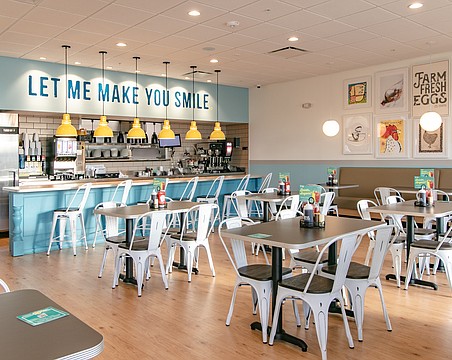Taming the Trail
By Sean Roth
Real Estate Editor
Wanted: Developers to revitalize a city's central thoroughfare. Must have mixed-use experience. Possible incentives include increased density, expedited permitting and review, tax-increment participation, government land assembly, tax abatements, below-market land prices and reduced setbacks and parking requirements.
Bradenton may soon send out ads like this following Wade-Trim Inc. and Siemon & Larsen PA's draft recommendations for revitalizing 14th Street, which were discussed at a July 11 meeting. Although the strategy was six months in the making and cost $68,000, very little of the recommendations surprised those who have been following the city's travails with the stretch of Tamiami Trail running north of Cortez Road into downtown. The crux of the solution suggests the use of government money and tools along with private investment to spur real-estate market forces to improve the struggling district.
Once a thriving downtown drag, 14th Street has deteriorated greatly in the past three decades becoming a haven for drug-users, prostitutes, criminals and the homeless. Following particularly the homeless population, a collection of about seven social service providers (among them The Salvation Army, Our Daily Bread Soup Kitchen and Project Light of Manatee Inc.) and short-term employment agencies joined the current retail lining the thoroughfare into downtown.
Faced with what is perceived as a continued decline in the marketplace, the city asked two consultants to jointly come up with an economically based solution to create a measurable turnaround in five to seven years.
One of the most controversial elements of the plan, which also includes mundane ideas such as increased density and zoning and lighting and streetscape improvements, suggests the city acquire more than 10 acres for eventual sale to a developer. That developer, with city incentives, would develop a mixed-used development of condominiums - starting at about $150,000 for 1,000 square feet - and retail. Targets for the city's major acquisition, the consultants suggest, should be the run-down motels, which Charlie Siemon of Siemon & Larson PA identifies as one of the chief reasons for the decline.
"These motels have no future," Siemon says. "It is inevitable that they will further decline. So if you need to buy land anyways, why not tackle two problems at once?"
That recommendation might sound familiar. About a month ago, Bill Theroux, executive director of the Bradenton Downtown Development Authority and director of the 14th Street CRA, was actively trying to buy the Manatee Inn, 1405 14th St. W., and two neighboring houses. By most reports, those negotiations fell apart when the motel owner publicly listed the property for sale for about $2.8 million - far more than the DDA appraised value for the property of $1.6 million.
Theroux, who told the Review that the Manatee Inn deal is still being discussed, says the city's recent efforts toward revitalizing the area are hurting its own efforts to acquire the property for true market value.
"By us focusing on the 14th Street areas that in itself is creating a market for property that has really never been there," Theroux says. "Many of these property owners never even had the opportunity to break even, but because of the CRA, we have already inflated those fair-market values. Some of that increase is fair, but a lot of it now is being fueled by people thinking that there are other buyers looking to buy out there besides us."
In the long term, Theroux expects the process to be a win-win for the city. Either the motels will be sold and knocked down by a new private owner or prices will go down and the city can acquire them.
But the biggest problem the city faces in its acquisition efforts is timing. After the land acquisition, city officials expect the request for proposal process and actual development to take at least two years. Theroux says the rosiest projection he has heard is that the acquisition would take a year to 18 months, which means the development would most likely be completed by 2010.
Given the tight schedule and an earlier failed attempt to acquire the land, talk has started circulating that eminent domain may have to be involved.
"This is something we have no intention of using," Theroux says. "But even so this is something that has always been lingering out there. Before the recent Supreme Court decision we hadn't considered it."
As for whether 14th Street would meet the definition of blight or slum necessary under Florida law for eminent domain, Theroux has no doubt.
"This area is blighted by the very fact that it is in a CRA area," he says. "Even so it's got a higher crime rate, more homeless and a gathering of all these different social service agencies. I think even in the state of Florida, which has a much more rigid definition than in the case before the Supreme Court, 14th Street, and most of the motels, would meet that definition."
Theroux says it would likely take about a year to use eminent domain to acquire the property, which makes the process at least as lengthy as trying to force a property change through a stepped-up nuisance abatement/code enforcement process.
"If property owners there continue to be unreasonable, it is always an option," Theroux says. "But that is certainly not our intent. We certainly have to be compassionate for the people that live there or own a business. They have certainly weathered the ups and downs of the market, so we can certainly appreciate them wanting the property value to come back. We just can't let them do it at the expense of the taxpayers."
As for why the city would have to acquire the property instead of a developer, Theroux says at last count the city was dealing with about 19 separate parcels of land, a process which is expensive and time consuming enough to scare away most developers.
Theroux says the DDA will probably finance the land purchase through a conventional bank loan.
The second and potentially larger obstacle brewing for the revitalization plan to be successful is the relocation of some of the social services groups from 14th Street to a multi-agency community resource center. According to Theroux, the city-acquired property would very likely encompass property for Our Daily Bread Soup Kitchen and at least one other social-service agency.
The social-service relocation is being considered a separate provision by the city but is obviously important to the public's perception of the development.
The Community Coalition on Homeless Inc., which is spearheading the one-stop resource center, is looking for a site within a mile of the 14th Street corridor.
"The social services problem on 14th Street is more of perception problem than reality," Theroux says. "The Salvation Army runs a very competent program there. They run a very restrictive program that doesn't provide services if the individuals are on drugs or drunk. It also makes them sign in and show ID. Unfortunately, not all the groups are as selective with their services. ... Other types of social services tend to attract the transient population (homeless by choice rather than through circumstances).
"If the citizens and merchants will be patient and supportive we believe we can reverse its 30-year decline and bring the neighborhood back to something we all can be supportive and proud of."





